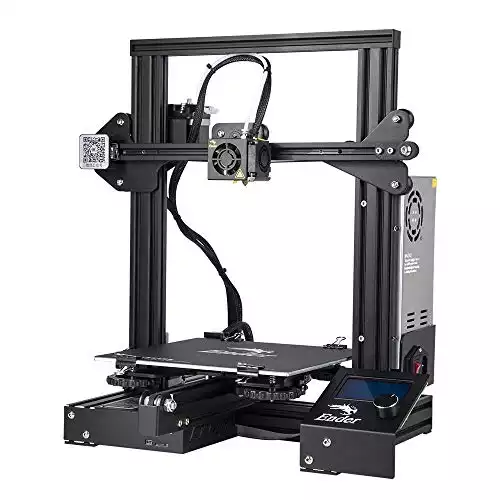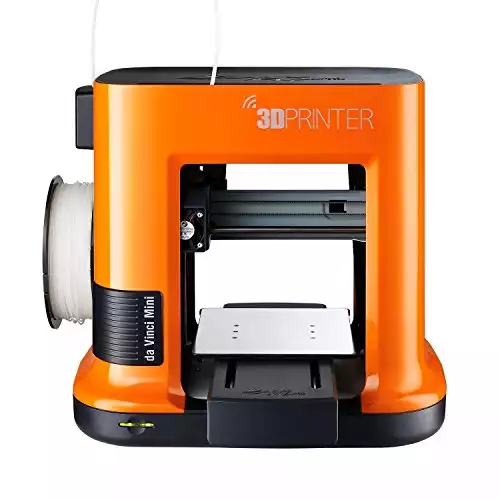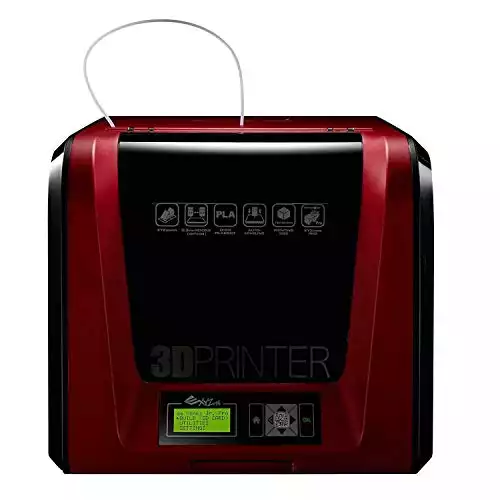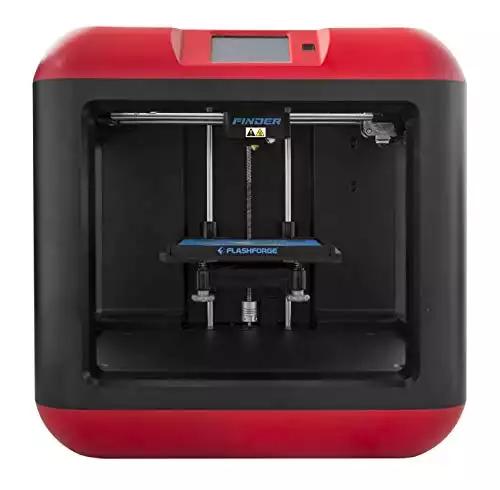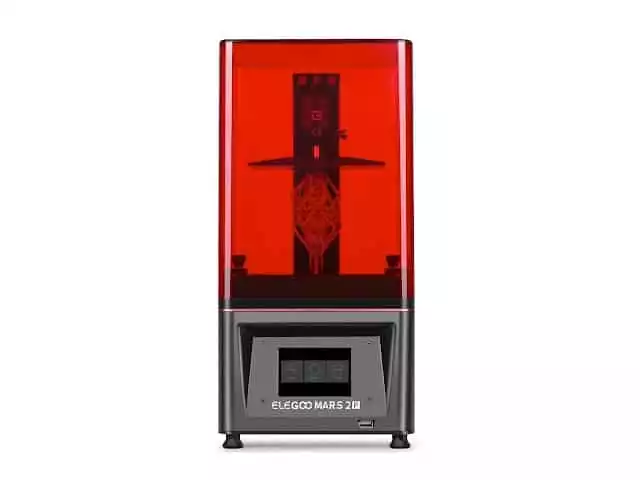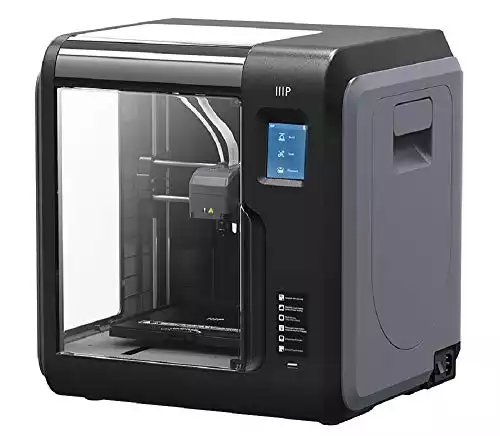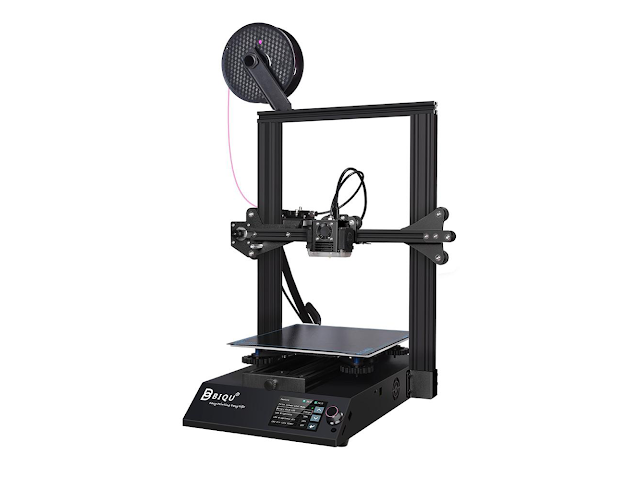- Top Things to 3D Print and Sell Online - May 22, 2023
3D Printers use to have an extremely high barrier to entry with the machines starting price points. As the 3D printing industry has grown and the machines have become more popular, companies are now producing great machines at a fraction of the cost.
Fortunately, these cost savings are trickling down to the customers in terms of prices and means a more affordable 3D printer. Now, remember, the cheapest 3D printer is not always the best one.
We thought it would be helpful to provide an overview of 7 of some of the most affordable options for 3D print applications.
Table of Contents
Our top 8 recommendations for affordable desktop 3D printers, all under $500:
1. Creality Ender 3
For most users, I recommend starting with this Creality Ender 3 Prusa i3 model here. It produces more consistent quality prints and is MUCH easier to assemble, let alone being more affordable. A clear choice for me.
Features
- Ender 3 Price: The Ender 3 is one of the most affordable desktop 3D printers you will see out there, period. You can find it for under $200 through all the vendors you associate with 3D printers, including Amazon, Gearbeast, and Creality itself. It’s not only affordable, but it’s also accessible, and you’ll have a lot of outlets to shop around to ensure you’re getting the best of the best deal Check out the latest prices on the Ender 3 here on Amazon. It tops our list if you’re looking for a 3d printer cheap.
- Ender 3 Assembly: You may still be wary after hearing the Ender 3 is a kit and not a fully assembled printer. So many 3D printers can pass themselves off as good deals because you’re doing all the work to get them going. But with the Ender 3, the assembly process is virtually painless. This good start to your experience gives you a boost to enjoy the rest of your printing sooner and with more understanding of how things work, making it one of the best cheap 3d printers out there.
- Ender 3 Size: Although the Ender 3 is by no means the largest – or smallest, if you’re into that – desktop 3D printer out there, its balance of print area and compactness makes it the golden ideal in its class. [size of printing area] is big enough for a large size range of personal projects, and you can always print pieces to assemble together into a larger finished object. And for the Ender 3, compactness is translated into putting a lot of great stuff into a package that doesn’t waste space. Desktop printing is always going to be a cramped market, so Ender 3 gives you plenty of room to do your thing without getting in the way of the rest of your life.
- Ender 3 Print quality: It might take a little adjusting after your first few runs, but the Ender 3 gets what you want to do in terms of print quality and helps that happen well. One of the ways it makes a great finished product is with its tight filament path – with fewer twists and turns for the filament to go through when it’s getting to the extruder, the smoother the print is going to be, especially when you’re working with flexible filaments like nylon.
- Open source software: The Ender 3’s upgrade system is the best we’ve seen in a kit printer. You’re not left alone to fumble with a system that’s going to be incompatible with everything else you want to use, and you’ll be able to take advantage of any (or all!) of Creality’s available updates. Those are growing by the day, as are the creative additions Creality users post for others to find and freely use on the internet. If you’re one to tinker around with code and put together something awesome, you can add your own ideas to the mix and get them out there for everyone to use.
Key Specifications
|
Printing technology |
FDM 3D Printer |
|
Print area (build volume) |
220 mm x 220 mm x 250 mm |
|
Printer size |
440 mm x 410 mm x 465 mm |
|
Printer weight |
8.6 kg |
|
Filament type |
1.75 mm PLA, ABS, or TPU |
|
Extruder Nozzle diameter |
0.4 mm |
|
Maximum print speed |
200 mm/sec |
|
Maximum layer resolution |
0.1 mm |
|
Print precision |
+/- 0.1mm |
|
Heated bed |
Yes |
|
Connectivity |
SD card, USB |
|
LCD screen |
Yes |
Further Reading:
- Ender 3 vs Prusa i3 MK3
- Creality Ender 3 vs Ender 5
- Creality Ender 3 vs Ender 3 Pro
- Creality Ender vs Anet A8
2. Anet A8
Easy installation, 5 keys 2004 LCD screen display, easy control, smart board, pause at anytime, best budget for DIY lovers.
Features
- DIY Kit: The printer comes almost entirely unassembled when it arrives. This means you will have an unforgettable learning experience as you piece your 3D printer together. Step-by-step instructions come loaded on an included SD card. It’s a bit of a hassle, but it’s part of what makes this 3D printer cheap.
- Pre-Loaded Instructional SD Card: Within the files on the SD card, you will find links for instructional videos. Overall, the assembly process sounds like a fun experience, and it will give you a great sense of accomplishment when it is completed.
- Design: We are big fans of the simple and sleek design of the Anet A8. An acrylic frame gives it a hand-made industrial feel, which looks great in your workspace. One of the best parts is the all-metal pulley system which means better performance and more durability. All rods, gears, bearings, and connectors are stainless steel parts, which allows for more precise and smoother printing.
- Quick Release Feed Gears: Also, it comes with quick-release feed gears linked to the extruder for seamless filament feeding. Overall, the build and design of the Anet A8 are quite impressive for the price you pay.
- Easy to Follow Instructions: The assembly process may be difficult for some of the more beginner users, but anyone can build it. We have heard the assembly process takes around 4 – 6 hours, but be sure to go slowly and take your time, patience is key when building this printer. Luckily, with such a large online following and support system you will have all the help you need.
- Multiple Filament Types: The Anet A8 is compatible with 6 different types of filaments, listed below in the key specs. Your options for printing and creating are almost endless. Everything from standard PLA to wood or even luminescent filaments will work on this machine. Through testing, we have heard the PLA seems to work the best when you first get the printer running.
Key Specifications
| Build Area | 8.6” x 8.6” x 9.5” |
| Print Speed | 100 mm/s |
| Filament Types | ABS, PLA, Wood, Nylon PVA, PP, Luminescent |
| Layer Resolution | 100 – 300 microns |
| Layer Thickness | 0,05mm – 0,35mm |
| Positioning Accuracy | 12 x 12 x 4 microns |
| Max Extruder Temperature | 500 °F / 260 °C |
| Max Heated Bed Temperature | 205 °F / 96 °C |
| Dual Extruder | No |
| Nozzle Diameter | 0.4 mm |
| Print Bed Leveling | Manual |
| Print Bed Details | Heated bed with aluminum surface |
| Display | LCD Screen |
| Firmware | Open Source |
| Warranty | None |
| Our Score | 8.4/10 |
| Price | $163.99 (For the latest prices and discounts, check here) |
3. XYZPrinting da Vinci Mini W
The da Vinci Mini streamlines its printing function through a single-button print design as well as providing different colored LEDs to indicate printing conditions.
Features
- Compact: The da Vinci Mini W weights less than 18lb which means you can easily transport it to wherever you go around the house or office.
- Large Print Size: The 5.9 x 5.9 x 5.9 inches aluminum print bed allows you to create big high-quality prints (reliable print quality).
- Print In No Time: Everything comes pre-tested, calibration has been done and all the print settings are calculated so you can start printing quickly after getting in touch with the printer.
- Easy Maintenance: The printer comes pre-assembled and it has auto-leveling software which makes the initial setup and maintenance straightforward.
- Environmentally Friendly: The da Vinci Mini W uses biodegradable and DEHP-free PLA print material.
Key Specifications
- Print Technology: FFF(Fused Filament Fabrication)
- Build Volume / Print Volume (L x W x H): 5.9″ x 5.9″ x 5.9″ (150 x 150 x 150 mm)
- Layer Resolution: 100 – 400 microns
- Filament Material: PLA / Antibacterial PLA / PETG / Tough PLA
- Filament Diameter: 1.75 mm
- Nozzle Diameter: 0.4 mm
- Operating Temperature: 15 – 32 °C / 59 – 89.6 °F
- Supported File Types: .stl , XYZ Format (.3w), .3mf , .obj
- Operating Systems: Windows 7 or Above, MacOS 10.10 / 10.11 / 10.12 / 10.13 / 10.14
- XYZ Positioning Precision: X/Y: 12.5 microns; Z: 0.001 mm
The XYZ Printing da Vinci Mini W(wireless) is our next choice for a great, affordable 3D printer. This is the first of two printers from XYZ Printing on our lists. This company has made a name for itself by producing some amazing machines and offering some of the cheapest in the industry.
The da Vinci Mini W was designed with the beginner in mind. It features a streamlined design with single-button printing and wireless connectivity. As well it utilizes the easy to use XYZprinting software to allow for easier print setup, which means more time printing.
This printer is limited to only XYZprinting’s bio-compostable PLA. While limited, you can rest assured you are not hurting the environment when using this filament.
The da Vinci Mini W has an average-sized build volume (print volume) of 5.9” x 5.9” x 5.9”, which is typical for “mini” models. You will also get a fairly standard 100 – 400 micron layer resolution with a max print speed of 120mm/sec.
The da Vinci Mini W doesn’t come with any eye-popping features. But it is reliable, sturdy, and consistent machine with a very friendly price tag.
Overall, I highly recommend this 3D printer for anyone who is new to the 3D printing world. Check out the full review here.
4. XYZprinting da Vinci Jr. 1.0 Pro
Print with any 3rd Party Filament: The da Vinci Jr. 1.0 Pro has adjustable temperature settings for the extruder nozzle, making it compatible with 3rd party 1.75mm PLA filaments.
Features
- 3rd Party Filament Compatibility: It has easily adjustable extruder nozzle temperature settings which makes it compatible with 3rd party PLA or PETG filaments. Additionally, with its auto-loading filament system, it ensures that the filaments are fed properly.
- XYZware Pro Software: Having this software will allow for faster slicing and increased control.
- Auto-Calibration: The printer uses a 9-point calibration detection system which helps to determine the distance between the print bad and the extruder more accurately.
- Convenient Design: The 19.88″ x 23.15″ x 18.7″ (505 x 588 x 475 mm) size of the printer makes it an ideal desktop 3D printer.
- Wide Range of Material Use: The printer is compatible with many filaments which are listed below.
- 0.3mm Nozzle: Although this doesn’t come included with the printer you can easily purchase this upgrade separately. It is well-suited for complicated print jobs. The 0.3mm extruder can create smoother prints with a resolution of 50 microns.
Key Specifications
- Print Technology: FFF(Fused Filament Fabrication)
- Max. Build Area (L x W x H): 5.9″ x 5.9″ x 5.9″ (150 x 150 x 150 mm)
- Layer Resolution: 50 – 400 microns
- Filament Material: PLA / Antibacterial PLA / PETG / Tough PLA / Wood / *Premium Metallic PLA / *XYZ Carbon Fiber (*Option Extruder)
-
Support 3rd Party Material: Yes
- Filament Spool Storage: Internal
- Filament Diameter: 1.75 mm
- Nozzle Diameter: 0.4 mm/ 0.3mm (optional)
- Operating Temperature: 15 – 32 °C / 59 – 89.6 °F
- Supported File Types: .stl , XYZ Format (.3w), G-code, .3mf , .obj
- Operating Systems: Windows 7 or Above; MacOS 10.10 / 10.11 / 10.12 / 10.13 / 10.14; Linux 14.04 / 16.04
- XYZ Positioning Precision: X/Y: 12.5 micron; Z: 0.0004 mm
As promised, we have our second XYZprinting printer, this time it’s the da Vinci Jr. 1.0 Pro. This printer is described as “a compact 3D printer for professionals” and that is exactly what it is. The da Vinci Jr. 1.0 Pro has all the capabilities and features of the more advanced high-end 3D printers but is available for under $400.
You’ll get all you need and more with the da Vinci Jr. 1.0 Pro. It comes as a fully-enclosed print bed environment, 5.9” x 5.9” x 5.9” build area, 3rd party filament compatibility, and an upgradeable nozzle to 0.3mm diameter size.
With the smaller diameter nozzle, you will be able to create higher resolution parts up to 50 microns. Typically, you need to give out thousands of dollars for that level of detail.
The layer resolution isn’t the only mind-boggling spec of the da Vinci Jr. 1.0 Pro. This affordable machine can reach print speeds of 250mm/sec. This is easily the top performing 3D printer in terms of specs on this list. And with a best cheap 3D printer price tag, you’d be crazy not to purchase this 3D printer.
Overall, this is easily one of my favorites for an affordable 3D printer. The da Vinci Jr. 1.0 Pro will get you the most bang for your buck when it comes to 3D printers. Check out the full review here.
5. Flashforge Finder
The Flashforge Finder is the perfect combination of approachability and reliability to be a great classroom performer. Not too big or complicated to overwhelm, but also consistent with no "open source" finicky customizations.
Core Features of the Flashforge Finder 3D Printer
- Non-Toxic Plastic Filament: Specifically designed to print models using biodegradable plastic filaments know as Polylactic acid (PLA). This removes the complication of needing a heated print bed to work with more problematic (and toxic) materials like ABS
- Intelligent Assisted Leveling System: This is a feature mostly found on expensive printers that allow the user to precisely calibrate the distance between the nozzle and the build plate. I
- Wired and Wireless Connections: The 3D printer features a 2nd generation Wi-Fi connection as well as support for a USB flash drive and direct connection with a computer.
- Filament Management System: This key feature that allows this printer to be a perfect cube in size is its excellent filament management system. The filament is contained inside a cartridge that slides into the back of the printer.
- 3.5” HD IPS Touchscreen: Finder sports a touch screen at the top of the printer, allowing for easy operation of the printer. It is also able to show previews of the model files before you start a print, as well as a real-time view of printing status.
- Plug and Play: One of the main selling points of the Flashforge Finder is that it is a plug and play printer. Anyone can start 3D printing immediately and there is no need for test prints. And that is exactly what this printer delivers.
Key Specifications
- Printing Tech: FFF (Fused Filament Fabrication)
- Build Volume: 5.5” x 5.5” x 5.5” (140 x 140 x 140 mm)
- Layer Resolution: 100~500 microns
- Positioning Precision: XY: 11 microns, Z: 2.5 microns
- Printing Speed: 40 ~ 200 millimeters per second
- Nozzle Diameter: 0.4 mm
- Product Dimension: 16.5” x 16.5” x 16.5” (420 x 420 x 420 mm)
- Connectivity: Wi-Fi Network, USB Cable, USB Flash Drive Stick
- Operating Systems: Windows 7/ 8 / Vista Mac OS X
- Software: FlashPrint
The Flashforge Finder is the latest, greatest, smallest in the long line of high-quality 3D printers from Flashforge. It contains most of the great features the other Flashforge models have just on a smaller scale, which also means its a more affordable 3D printer than its counterparts.
This printer comes equipped with an easy to use 3.5” color touchscreen display, a slide-in build plate for easy removal of final products, and multiple connectivity options. You can connect it to your home network and print from anywhere in your home or office.
Also, with the Finder, you will get a 5.5” x 5.5” x 5.5” build area, and it can reach layer resolutions of 100- 500 microns. Unfortunately, this one is limited to PLA only filament and it may be tricky to try and upgrade any parts.
Overall, the Flashforge Finder is aimed at beginners with its easy price tag and simple design and features. If you need a quality 3D printer from a well-known 3D printing company, this is a great option. Check out the full review here.
6. ELEGOO Mars 2
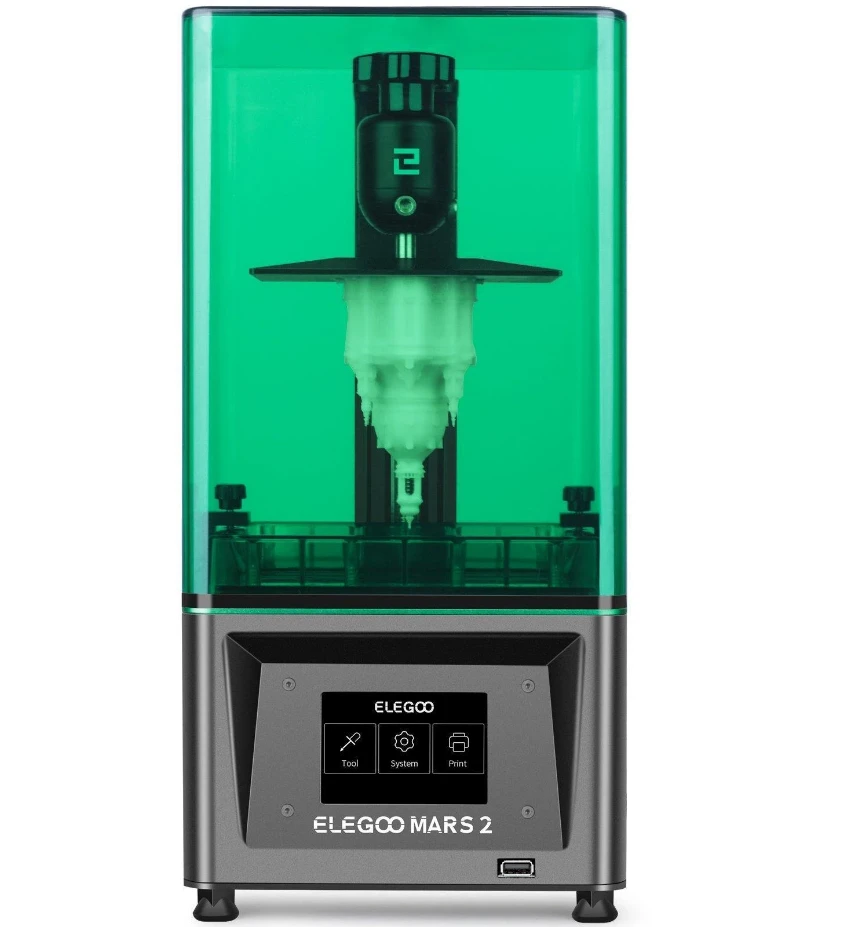
Features
- Fast monochrome LCD printing: When it comes to LCD printing, monochrome LCDs are quicker and more affordable than colored LCDs. The ELEGOO Mars 2 has a large 6.08-inch (15.4 centimeters) monochrome LCD that’s twice as speedy as the regular colored ones. What’s more, the UV light source only needs two seconds to cure each layer.
- Accurate and detailed: The UV light can provide accurate and precise layers, making details stand out.
- Durable build: The frame of this 3D printer is made out of aluminum. Meanwhile, the sandblasted build plate makes it easier for your models to adhere to the hotbed.
- Speaks your language: The ELEGOO Mars 2 supports 13 languages, including Japanese, Korean, French, Russian, German, Italian, Spanish, Portuguese, and Turkish.
- One-year warranty: ELEGOO covers the printer with a one-year warranty and six months warranty for the LCD.
Key Specifications
| Dimensions | 7.9 by 7.9 by 16.1 inches (20 by 20 by 41 centimeters) |
| Weight | 13.7 pounds (6.2 kilograms) |
| Print Technology | UV photocuring |
| Build Volume (L x W x H) | 5.1 by 3.2 by 5.9 inches (129 by 80 by 150 millimeters) |
| Layer Thickness | 0.01 to 0.2 millimeters |
| Printing Speed | 30 to 50 millimeters (1.2 to 2.0 inches) per hour |
| Z-Axis Accuracy | 0.00125 millimeters |
| XY Resolution | 0.05 millimeters |
| Light Source | UV integrated light (Wavelength 405nm) |
| Connectivity | USB |
| Operation | 3.5-inch touchscreen |
| Power Requirements | 100 to 240 volts, 50/60 Hertz |
The ELEGOO Mars 2 is an affordable LCD 3D printer that doesn’t look its price. It has a slick design and can print fast. At its price, it doesn’t have the advanced features that most other 3D printers now have. But that’s okay.
With highly detailed prints and fast operation, you can’t go wrong with the ELEGOO Mars 2.
The Elegoo Mars is great for beginners. It’s forgiving and rewarding at a great price point so you can enjoy consistent successful prints, high-quality performance, and little effort. UPDATE: The new Mars 2 Pro Mono is even better, with built in air purifier, resin printer, and FASTER print speeds.
7. Monoprice Voxel
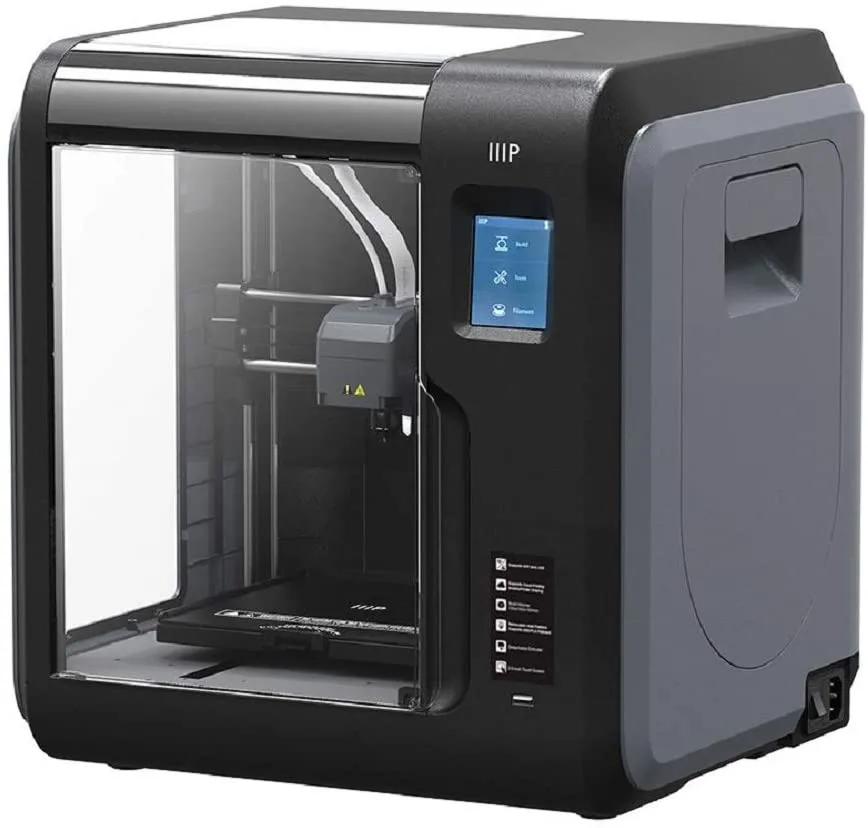
Features
- Assisted leveling: While the Monoprice Voxel 3D printer doesn’t feature automatic bed leveling, it does help you in the process. What’s more, you only need to tap on the touch display to do this.
- Quick change nozzle: Monoprice Voxel allows you to change the nozzle in just seconds, instead of the 20 to 40 minutes it takes with other printers. The Voxel is one of the best cheap 3d printers because you don’t even have to use tools.
- Removable build plate: The Monoprice Voxel has a removable build plate that you can twist and flex to remove the printed model. You no longer have to use scrapers and other removal tools. The plate can be heated up to 140 degrees Fahrenheit (60 degrees Celsius).
- Polar Cloud: The Monoprice Voxel connects to the Polar Cloud, so you can operate your 3D printer from anywhere in the world just as long as you have an Internet connection. And with the included web camera, you can even watch how your print is coming along.
Key Specifications
| Dimensions | 15.7 by 15.0 by 15.9 inches (400 by 380 by 405 millimeters) |
| Weight | 19.8 pounds (9.0 kilograms) |
| Filament Size | 1.75mm |
| Nozzle Diameter | 0.4mm |
| Build Area | 6.9 by 6.9 by 6.9 inches (150 by 150 by 150 millimeters) |
| Layer Resolution | 0.05 ~ 0.4 mm |
| Build Accuracy | ±0.2mm |
| Build Speed | Up to 3.9 inches (100 millimeters) per second |
| Internal Memory | 8 gigabytes |
| Software | MP FlashPrint |
| Connectivity | USB Flash Drive, Wi-Fi, Ethernet |
| Operating System Compatibility | Windows, Mac OS X, Linux |
The Monoprice Voxel is an affordable yet capable 3D printer. You will think that the manufacturer sacrificed a lot of features to lower the price, but that is not the case.
You still have wireless connectivity, allowing you to send your designs to the printer via Wi-Fi. And with Polar Cloud, you and the printer doesn’t even have to be in the same location.
However, it does have a small build volume at only 6.9 by 6.9 by 6.9 inches (150 by 150 by 150 millimeters). You are also limited when it comes to your choice of slicers.
The Monoprice Voxel 3D Printer makes it really easy to get started, and the excellent print quality leaves every experienced users satisfied.
8. Biqu B1
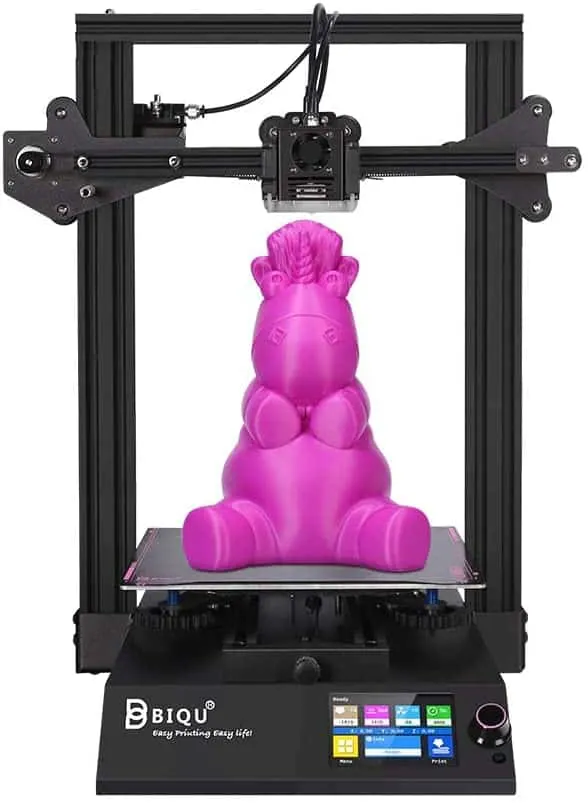
Features
- Big build quality and flexible print sheet: You can print tall objects with the Biqu B1, which you can flex right off the print sheet with just a bit of a twist.
- Quick heating: The Biqu B1’s bed can get up to 212 degrees Fahrenheit (100 degrees Celsius) while the extruder reaches 500 degrees Fahrenheit (260 degrees Celsius). The good news is that it can get hot temperatures at a fraction of the time that it takes other printers.
- Plug and play: This 3D printer has stock settings that allow you to print almost out of the box.
- Excellent interface: You can operate your 3D printer using the touch display. This allows you to tweak everything for your machine. But you can also switch to using the rotary knob on the side of the touch display.
Key Specifications
| Dimensions | 16.2 by 19.4 by 15.8 inches (412 by 492 by 402 millimeters) |
| Weight | 17.6 pounds (8 kilograms) |
| Technology | Fused deposition modeling (FDM) |
| Build Volume | 9.3 by 9.3 by 10.6 inches (235 by 235 by 270 millimeters) |
| Print Head | Single nozzle |
| Nozzle Size | 0.4 mm |
| Bed Leveling | Manual |
| Camera | No |
| Connectivity | MicroSD card, USB |
| Filament Diameter | 1.75 mm |
| Filament Materials | PLA, ABS, PETG, Flexibles and other consumer filaments |
| Filament Sensor | Yes |
| File Types | STL, OBJ, AMF |
| Operating System | Windows, Mac OSX, Linux |
| Print Recovery | Yes |
| Recommended Slicer | Cura, Simplify3D, Repetier-Host |
| Third-Party Filament | Yes |
The Biqu B1 is upgradable with several spare parts for those who want to get more out of their 3D printer. It also delivers excellent print quality.
From the convenient “Super Steel Sheet”, to the high quality SKR board with plenty of expansion potential, to the innovative dual-UI which lets you hot-swap between the Marlin UI to a custom touchscreen interface.
Side-by-Side Comparison: The Best Budget Printers
To make it breezier for you to choose, check out this comparison table:
| Printer | Biqu B1 | ELEGOO Mars 2 | Monoprice Voxel | Creality Ender 3 | Anet A8 | XYZPrinting da Vinci Mini W | Flashforge Finder |
| Price | Less than $300 | Around $200 | Around $400 | Less than $200 | Around $200 | Less than $250 | Around $350 |
| Dimensions, inches | 16.2 by 19.4 by 15.8 | 7.9 by 7.9 by 16.1 | 15.7 by 15.0 by 15.9 | 17.1 by 17.7 by 24.2 | 20.1 by 15.7 by 16.3 | 15.8 by 14.3 by 13.2 | 16.5 by 16.5 by 16.5 |
| Dimensions, millimeters | 412 by 492 by 402 | 200 by 200 by 410 | 400 by 380 by 405 | 435 by 450 by 615 | 510 by 400 by 415 | 401.3 by 363.2 by 335.3 | 419.1 by 419.1 by 419.1 |
| Weight, pounds | 17.6 | 13.7 | 19.8 | 15.7 | 18.7 | 24.2 | 24.2 |
| Weight, kilograms | 8.0 | 6.2 | 9.0 | 7.1 | 8.5 | 11 | 11 |
| Technology | FDM | UV photocuring | FDM | FDM | FDM | FFF | FFF |
| Build volume, inches | 9.3 by 9.3 by 10.6 | 5.1 by 3.2 by 5.9 | 6.9 by 6.9 by 6.9 | 8.6 by 8.6 by 9.8 | 8.6 by 8.6 by 9.5 | 5.9 by 5.9 by 5.9 | 5.5 by 5.5 by 5.5 |
| Build volume, millimeters | 235 by 235 by 270 | 129 by 80 by 150 | 150 by 150 by 150 | 220 by 220 by 250 | 220 by 220 by 240 | 150 by 150 by 150 | 140 by 140 by 140 |
| Camera | No | No | Yes | No | No | No | No |
| Connectivity | MicroSD card, USB | USB | USB, Wi-Fi, Ethernet | SD card and USB | USB | USB, Wi-Fi | Wi-Fi, Flash drive, USB |
| Materials | PLA, ABS, PETG, Flexibles and other consumer filaments | 405 nm UV resin | ABS, PLA, PETG, exotics, and similar filaments | PLA, ABS, and TPU filaments | ABS, nylon PVA, PLA, PP, wood fill, and others | PLA | PLA |
| File Types | STL, OBJ, AMF | STL | 3MF, STL, OBJ | STL, OJ, G-code | STL, OBJ | 3W, STL | STL |
| Operating System | Windows, Mac OSX, Linux | Widows, Mac OS | Windows, Mac OS X, Linux | Windows, macOS | Windows, Mac OS, Linux | Windows and macOS X | Windows, macOS |
| Recommended Slicer | Cura, Simplify3D, Repetier-Host | ChiTuBox | MP FlashPrint | Creality Slicer, Cura, Simplify3D, Slic3r | Cura, Repetier-Host | Ultimaker Cura | FlashPrint |
Frequently Asked Questions about Best Cheap 3D Printers
Question: Are there 3D printers that are worth less than $100?
Answer: It’s worth noting that there are 3D printers that cost less than $100. However, we haven’t tested these printers, so we can’t really recommend them.
At those prices, these products are marketed towards children and beginners. For instance, the Frifer Upgrade 3D Printer.
At that price, the 3D printer has a build volume of 3.9 by 3.9 by 3.9 inches (100 by 100 by 100 millimeters) and a rated accuracy of 100 micrometers.
This printer is very easy to assemble, with only two parts to put together. There is an included assembly video.
The machine is also a silent worker with noise levels of less than 60 decibels. It’s also compatible with CURA, Simplify3D, and Easyware.
A look at the specifications can give you an idea of what it can do:
- Dimensions: 8.1 by 8.3 by 9.6 inches (205 by 210 by 245 millimeters)
- Weight: 2.9 pounds (1.3 kilograms)
- Connectivity: TF Card and USB
- File compatibility: STL
- Materials: PLA
- Nozzle diameter, millimeters: 0.4
- Printing accuracy, millimeters: 0.1 to 0.2
- Printing layer thickness, millimeters: 0.05 to 0.3
- Printing speed: 0.4 to 1.6 inches (10 to 40 millimeters) per second
- Printing temperature: 356 to 446 degrees Fahrenheit (180 to 230 degrees Celsius)
- Slicing software: Easyware, CURA, Simplify3D
FAMURE 3D Printer is another option for a 3D printer that’s below $100.
Question: Any tips when buying budget 3D printers?
Answer: You can do two things so that you don’t end up with a cheap 3D printer that does nothing but give you heartaches.
- Read the reviews. Check out the reviews made by credible reviewers. For one, Total 3D Printing does not only give you honest and accurate assessments, but we also do not have relationships with manufacturers to highlight only the positive. When there’s something wrong with a 3D printer, you’d know about it while reading our reviews.
- Buy from a popular brand. Creality and other bigger brands have better customer service to answer your questions or help you with your technical problems. What’s more, if there are more buyers of a particular printer, chances are users will be sharing their knowledge and files that you can use.
Of course, apart from these two, you should choose a printer that’s right for you. Figure out first why you want to buy a 3D printer in the first place. If you’re looking to print simple stuff, a single extruder FDM printer will be great. But if you need to use two colors or materials, get a 3D printer with dual extruders.
Further, if you want to print miniatures with very intricate details, then get an SLA. Of course, you will also need to get a printer that will fit in your space.
Question: Should I buy a budget printer from Kickstarter?
Answer: There are many points that can bolster the two sides of the Kickstarter argument. On the one hand, people are arguing that they could buy excellent printers at very deep discounts. Plus, some people see it as pre-order activity on the part of the company.
However, you should be aware that Kickstarter isn’t a store. You won’t have any guarantees that the money you paid will result in you getting a 3D printer. If the project fails to produce the product, then you will lose your money.
Cheap 3D Printers to Avoid
The five printers mentioned above are all solid value for the price. We are very comfortable recommending them to readers as we have used them ourselves! However, there are some other cheap 3D printer options that you should steer clear of.
In our experience, these 3D printers are inexpensive for a reason and you will be more frustrated with your investment in the long run. Some of these companies are just going through “growing pains” so it is entirely possible that later iterations will be much better. As it stands now, stays away from the following models:
Cubify Cube 3D Printer (2nd Gen): We were pretty excited when this printer was released as it had the appearance of the polished machine. What you get – however – is a printer that looks nice as a paperweight, but is barely functional as a 3D printer. There are many and a wide variety of complaints about it.
1) First, it has a very difficult time printing with ABS material. ABS and PLA are the two industry standards for printable material. Almost every printer can use both effectively. The worst part is that the machine advertises that it does – in fact – print ABS when this is clearly not the case.
2) Secondly, the replacement cartridges are vastly overpriced. I’m assuming this is part of the business model, much like what HP does with traditional “authorized” ink replacement. This might be acceptable if the rest of the 3D printing industry behaved this way. The truth is that many of the open systems and even some of the closed systems offer flexible cartridge fulfillment from various affordable suppliers.
3) Lastly, the machine is built on simplicity. Normally this would be a nice thing as an introductory model for beginners. However, the machine is simple and stupid! It is needlessly slow – slower than many of its competitors – while also being marginally reliable in terms of production print quality. Even the WiFi capability is tricky to configure. All in all, this is a poorly executed product.
It’s a shame that the core product is so poor because we found the customer support to be very helpful and courteous, as much as they could be given the circumstances. Just to reiterate, we do NOT recommend trying to save a few bucks with this 3D printer. You will be much better served by selecting a model from the table below, even if you aren’t a 3D printing enthusiast (yet).
Further Reads on Other Cheap 3D Printer Options
- Monoprice Select Mini V2 3D Printer Review
- The Ultimate Monoprice Maker Select V2 3D Printer Review for 2019
- Snapmaker Review – An Affordable 3-in-1 Printer
- Lulzbot Mini Review
- Bibo 2 Review
- Up Mini 2 Review
- Intamsys FunMat HT Review
- Our Best CoreXY 3D Printers For Your Needs
- Anycubic Chiron 3D Printer
- Anycubic Mega X Review


